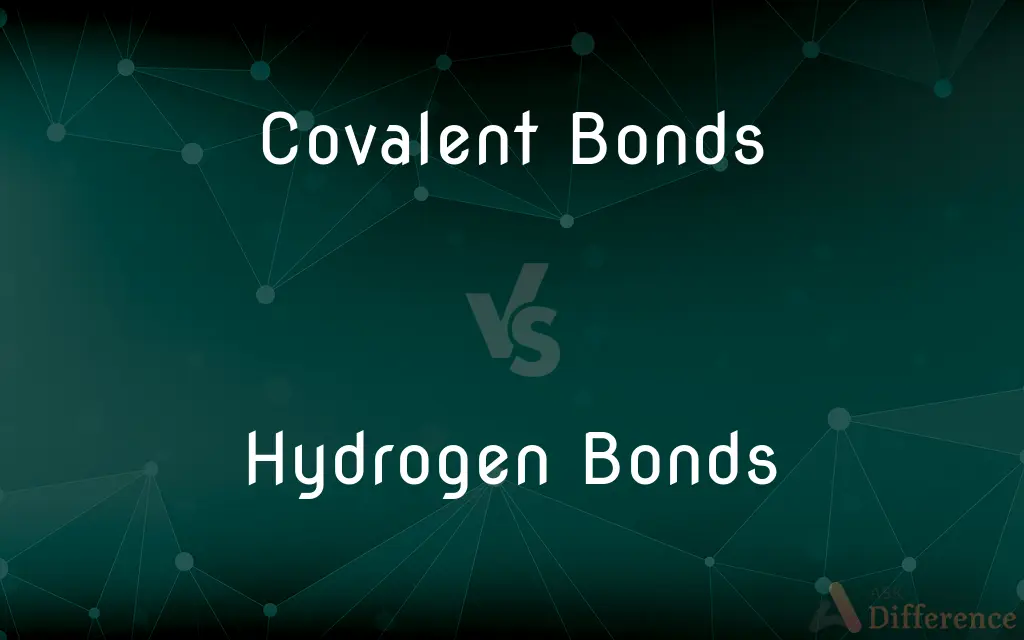Covalent Bonds vs. Hydrogen Bonds — What's the Difference?
Edited by Tayyaba Rehman — By Fiza Rafique — Published on January 11, 2024
Covalent Bonds involve the sharing of electron pairs between atoms; Hydrogen Bonds are weaker, occurring due to attraction between hydrogen and a more electronegative atom.

Difference Between Covalent Bonds and Hydrogen Bonds
Table of Contents
ADVERTISEMENT
Key Differences
Covalent Bonds and Hydrogen Bonds are integral to the world of chemistry, but they function distinctly. Covalent Bonds represent a strong form of chemical bond created by the sharing of one or more pairs of electrons between atoms. This sharing leads to a stable balance of attractive and repulsive forces. In contrast, Hydrogen Bonds are notably weaker and arise from the electrostatic attraction between a hydrogen atom, which is covalently bound to a highly electronegative atom, and another electronegative atom nearby.
Diving deeper, Covalent Bonds are typically found within a molecule, holding its atoms together. This bond ensures the molecule's stability, as electrons are shared and not transferred. Hydrogen Bonds, on the other hand, are often seen between molecules, playing a crucial role in holding large molecules like proteins and nucleic acids in their functional shapes.
The strength difference between Covalent Bonds and Hydrogen Bonds is significant. Covalent Bonds are much stronger and require more energy to break. Hydrogen Bonds, due to their weaker nature, can be easily disrupted by factors like heat and changes in pH. Yet, the cumulative effect of multiple Hydrogen Bonds can impart significant stability, as seen in the structure of DNA.
In many biological systems, both Covalent Bonds and Hydrogen Bonds coexist, serving specific purposes. While Covalent Bonds maintain the primary structure of molecules, Hydrogen Bonds assist in forming secondary and tertiary structures, particularly in biomolecules. Without these bonds working in harmony, life as we know it would not be possible.
Comparison Chart
Type of Bond
Intra-molecular (within molecules)
Inter-molecular (between molecules) or intra-molecular
ADVERTISEMENT
Bond Strength
Strong
Weak
Formation
Sharing of electron pairs
Electrostatic attraction between hydrogen and an electronegative atom
Disruption Energy
High
Low
Biological Importance
Forms primary structure of molecules
Involved in secondary and tertiary structures of biomolecules
Compare with Definitions
Covalent Bonds
Create strong connections between atoms.
The Covalent Bonds in diamonds make them exceptionally hard.
Hydrogen Bonds
Easily disrupted by factors like heat.
Raising the temperature can break Hydrogen Bonds in a solution.
Covalent Bonds
Result from electron sharing.
The molecule remained stable due to its Covalent Bonds.
Hydrogen Bonds
Are weaker than covalent bonds.
The Hydrogen Bonds in water cause its high boiling point.
Covalent Bonds
Exist within molecules.
Water's H2O structure is maintained by its Covalent Bonds.
Hydrogen Bonds
Arise due to electrostatic attractions.
DNA's double helix is held together by Hydrogen Bonds.
Covalent Bonds
Require significant energy to break.
Breaking the Covalent Bonds in the compound required a lot of heat.
Hydrogen Bonds
Can occur between or within molecules.
The Hydrogen Bonds in proteins help maintain their shape.
Covalent Bonds
Lead to molecule stability.
Covalent Bonds ensure that methane remains CH4.
Hydrogen Bonds
Critical for biomolecule structures.
Hydrogen Bonds in enzymes ensure they function correctly.
Common Curiosities
How do Hydrogen Bonds differ in strength from Covalent Bonds?
Hydrogen Bonds are considerably weaker than Covalent Bonds.
Are Covalent Bonds found within or between molecules?
Covalent Bonds are primarily found within molecules.
Which bond is typically stronger?
Covalent Bonds are typically stronger than Hydrogen Bonds.
Which bond is crucial for the structure of DNA?
Hydrogen Bonds play a key role in maintaining the structure of DNA.
Are Covalent Bonds based on electron sharing or transfer?
Covalent Bonds are based on the sharing of electrons.
What forms Covalent Bonds between atoms?
The sharing of one or more pairs of electrons forms Covalent Bonds.
Do Hydrogen Bonds require a hydrogen atom to form?
Yes, Hydrogen Bonds involve a hydrogen atom covalently bonded to a more electronegative atom.
Can Hydrogen Bonds form within a single molecule?
Yes, Hydrogen Bonds can form either between molecules or within a single molecule.
How are Hydrogen Bonds important in proteins?
Hydrogen Bonds help maintain the secondary and tertiary structures of proteins.
Can environmental factors easily disrupt Hydrogen Bonds?
Yes, factors like heat and pH changes can easily disrupt Hydrogen Bonds.
How do Hydrogen Bonds form in water?
In water, Hydrogen Bonds form due to attractions between the hydrogen of one water molecule and the oxygen of another.
Are Covalent Bonds found in all molecules?
Not all, but many molecules contain Covalent Bonds to hold their atoms together.
In terms of energy, which bond is easier to disrupt?
Hydrogen Bonds are easier to disrupt as they require less energy compared to Covalent Bonds.
Which bond ensures the primary structure in biomolecules?
Covalent Bonds ensure the primary structure of biomolecules.
Are both bonds important in biological systems?
Yes, both Covalent Bonds and Hydrogen Bonds play vital roles in biological systems.
Share Your Discovery

Previous Comparison
Ahi vs. Mahi
Next Comparison
WhatsApp vs. TelegramAuthor Spotlight
Written by
Fiza RafiqueFiza Rafique is a skilled content writer at AskDifference.com, where she meticulously refines and enhances written pieces. Drawing from her vast editorial expertise, Fiza ensures clarity, accuracy, and precision in every article. Passionate about language, she continually seeks to elevate the quality of content for readers worldwide.
Edited by
Tayyaba RehmanTayyaba Rehman is a distinguished writer, currently serving as a primary contributor to askdifference.com. As a researcher in semantics and etymology, Tayyaba's passion for the complexity of languages and their distinctions has found a perfect home on the platform. Tayyaba delves into the intricacies of language, distinguishing between commonly confused words and phrases, thereby providing clarity for readers worldwide.













































